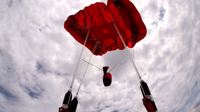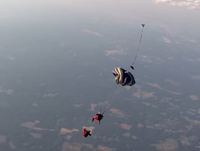The weather was questionable, but I went to Orange anyway. In my world, the planets were aligned and the staff at Orange recommends that you plan to attend ground school regardless of the weather. Some people think it is more beneficial to do the first jump course and then return a week later to make the jump. On this particular day, there were only two people in category A ground school. A man named Forrest who had never jumped before and myself. Ned was our ground school instructor.
At Orange, they use something called the USPA Integrated Student Program. The training is divided by categories A - H. In each category, the student is required to perform certain tasks before being moved on to the next category. I managed to pass from category A to category B with my tandem jumps because I had deployed the parachute on two of the three jumps, kept track of the altitude and practiced canopy control. In order to complete my Category B training and convert over to AFF (Accelerated Free Fall), I was required to complete the Category A ground training.
Category A ground school covers:
Equipment Orientation, Freefall Position, Main Canopy Deployment, Canopy Skills, Landing Procedure including problems, Equipment Problems, and Emergency Procedures.
Category B - Learning and Performance Objectives:
Relaxing, Heading Awareness, Parachute Deployment, Landing Pattern, Written Flight Plan, Airport Orientation, Protecting Handles, and Equipment Emergency Review.
To prepare for the day, I studied Categories A and B in the Skydiver's Instruction Manual (SIM).
During ground training, there were frequent breaks because Ned had other responsibilities. We used the time to practice emergency procedures. Forrest and I took turns in the harness. Once we were finished with the book training, Ned gave us a written test to see if we understood what we had learned. Then, we waited for an AFF instructor to talk to us about our jumps.
Mike French worked with us together and separately. My jump was going to be a little different than Forrest's. I'd be exiting the plane from the outside. Cool! I'd have two instructors with me. One holding on to my right side and one holding onto my left, but we would be standing on the outside of the plane.
Category B freefall tasks:
- Relax and Arch
- Circle of Awareness (check altitude, check in with both instructors)
- Adjust my body for any hand signals
- Three practice pulls
- Circle of Awareness
- Leg Extensions (Extend legs for three seconds and hold - Repeat)
- Lock on at 6,000 feet
- Wave off at 5,500 feet
- Pull
- Arch
We finished our ground training just in time for a weather hold.



